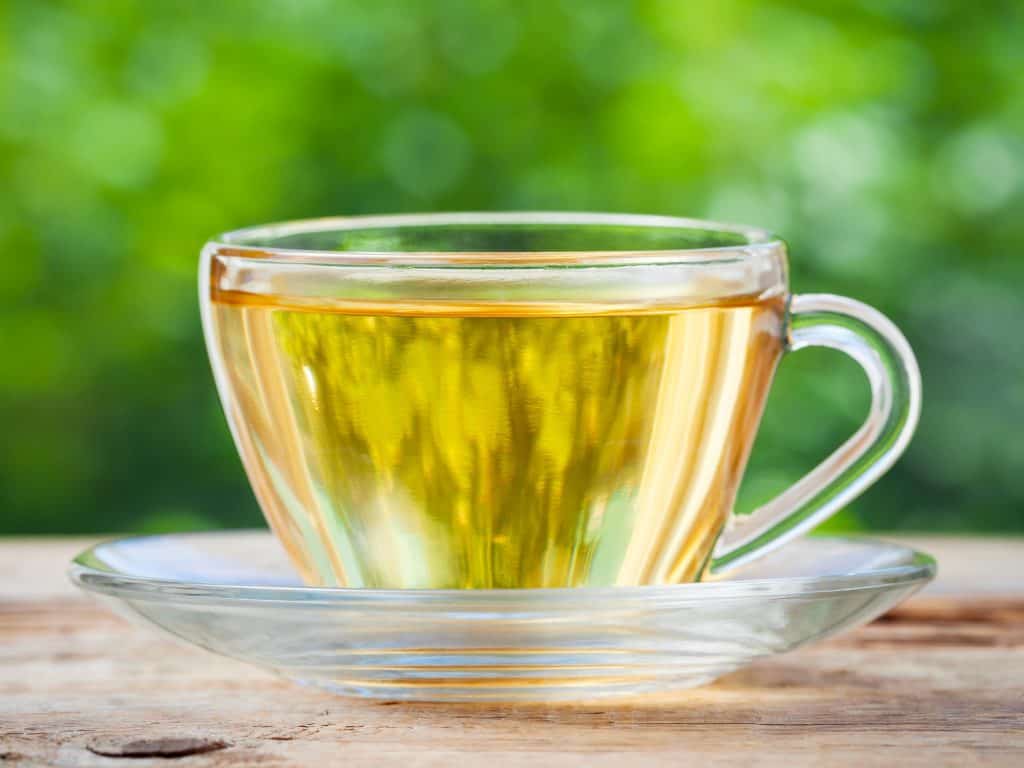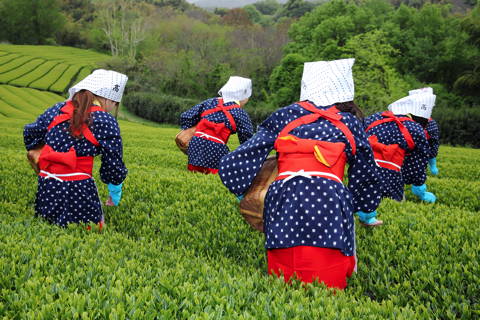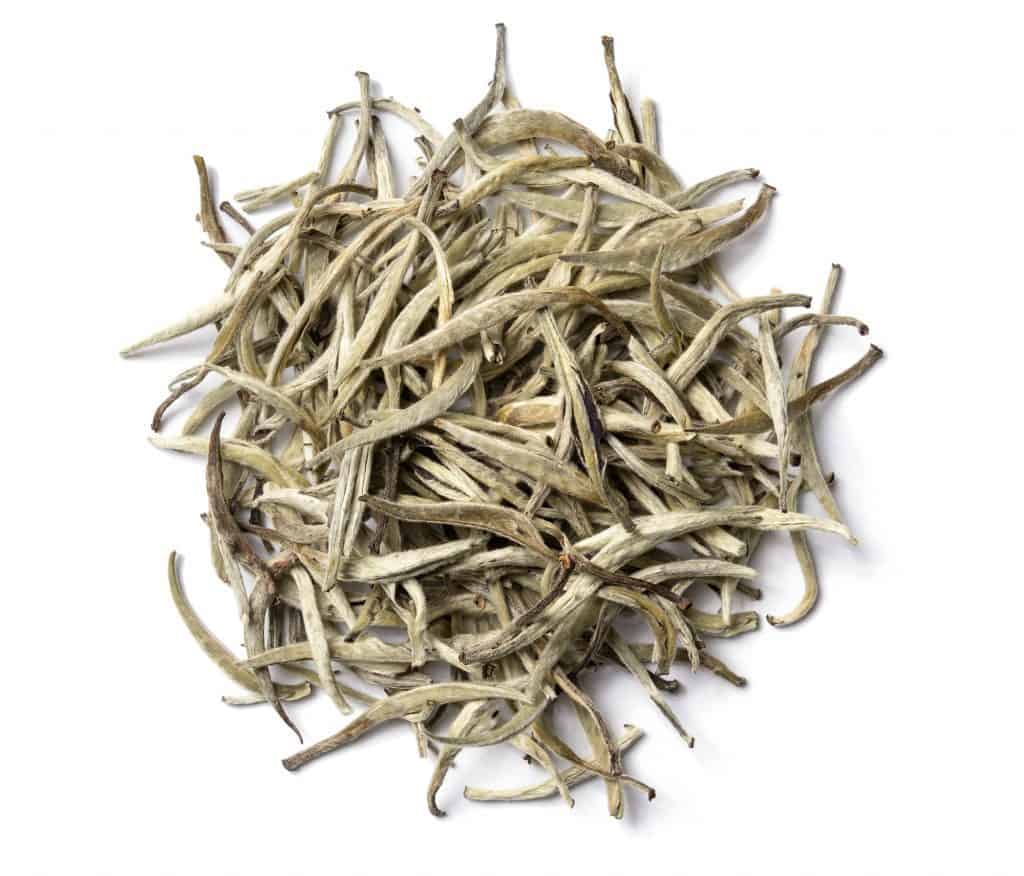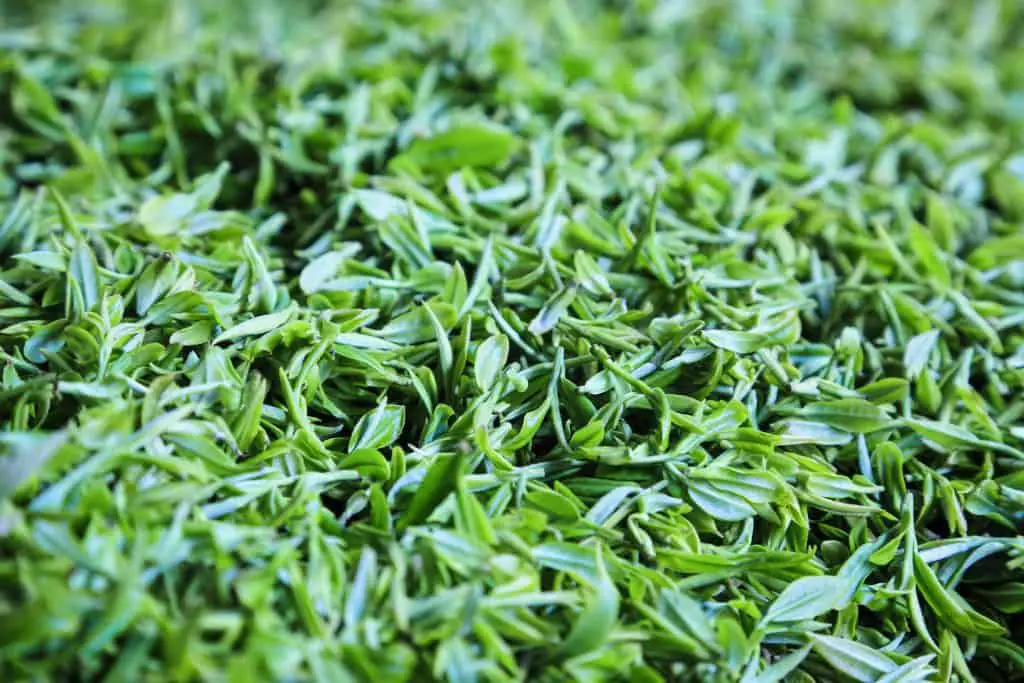
Tea fans, it is time to face an uncomfortable truth about our passion, and the truth is as follows:
Some of the very teas that make us happy when they dance about our taste buds can also have unpleasant side-effects when they work through our blood stream and beyond.
For instance, you may love the rich and malty finish of an orthodox black tea but the bitter tannins tie your tummy into knots.
Or you swoon over the grassy, umami mouthfeel of a shade-grown green tea but the high levels of caffeine make your head spin.
Side-effects such as these can be so potent that you may have altogether ditched a particular type of tea.
Now that is a tragedy! You have lost the parts of a tea that you enjoy and along with it all other benefits.
Fortunately, the modern tea market has a lot of options for those seeking alternatives. Today I will explore one such alternative, the white teas, which offer a solution to some common complaints about tea, especially bitterness and high caffeine.
At the same time, white teas offer unique aromas, flavors, and mouth sensations.

Later in this post, I will offer my recommendations for where you can find the best white teas on the market at affordable prices.
If want to go straight to the tea reviews, please click on the navigation menu below and head directly there. Otherwise, read on to learn more about white teas.
Table of Contents
- The White Tea Alternative
- Benefits of White Tea
- What is White Tea?
- The White Tea Secret: Less is More
- Does White Tea Have Caffeine?
- Where to Find The Best White Tea Brands: Our Recommendations
- #1. Best Daily White Tea: Organic Positively Tea Co. White Peony Tea (Bai Mu Dan)
- #2. Best White Tea for Special Occasions: Tealyra Premium Organic Silver Needle (Bai Hao Yin Zhen) from Fujian, China
- #3. Best White Tea for Introduction and Gifting: Vahdam Teas White Tea Sampler
- #4. Best White Tea Bags: Teabox Himalayan Darjeeling White Tea
- #5. Best White Tea Brand When You Want Something Unusual: Aged White Peony Tea (Bai Mu Dan) by Bamboo Mist Tea
- Summary Recommendations: Where to Find the Best White Tea Brands
- Teaware That You Will Need
The White Tea Alternative
Tea drinkers all over the world are beginning to devote more cupboard space to white teas, and for good reason. Though there is variation between the best brands of white teas, the flavor profile opens a sip with a floral and fruity note that finishes with a delicate and soothing mouthfeel.
Another special quality of white teas is the reduction or elimination of undesirable side-effects. In particular, those tummy-aches from too much tannic acid or the head-spins from too much caffeine are much easier to control through mindful consumption of white teas than in other teas.
There are many other benefits of drinking white tea. Here is a quick list that highlights the benefits that I consider significant.
Benefits of White Tea
To understand the source of these amazing benefits and why white tea stands apart from other teas, let’s look at the details of its manufacture.
What is White Tea?
As with other true teas, the white teas are made entirely from leaves of the Camellia sinensis tea plant. In the broadest terms, there are two styles of white tea. One style is white peony (or pai mu tan in Chinese) where farmers pluck the top two or three leaves on a stem along with the leaf bud at the tip.

Another style of white tea is called silver needle (bai hao yin zhen), where farmers harvest only tightly closed leaf buds. In fact, this style of white tea gets its descriptive name from the downy, silvery-white hairs that often cover young buds and so give the appearance of silver needles. Silver needle is considered among the highest grades of white tea.

White teas are lightly processed
After harvest of camellia leaf, the first stage of tea processing is withering. During withering the tea maker piles fresh leaf into shallow heaps under the cover of a leaf house (yes, that’s where this blog borrows its name).
Over the course of several hours or an entire day, the tea maker may periodically rearrange the leaf to ensure uniform wither.
Once the proper amount of moisture has been lost—this takes skill to recognize—the leaf is then carefully dried in either the sun or a hot oven.
The final steps in manufacturing are sorting and packing of the finished leaf. Therefore, when you put it all together, withering and drying are all there is to the processing of white tea.
A pretty simple procedure, right?

The white tea difference
In comparison to other types of camellia tea, the manufacture of white tea is indeed simple. Black, green, and oolong teas, for example, each have at least one step where the withered leaf is physically manipulated by either hand or machine.
There may also be additional processing steps in these teas that include heating by pan-frying or steaming. White tea, in contrast, is treated very gently from the time of leaf is harvested and throughout the withering step.
The point of all the added handling in other teas is to release phytochemicals from within leaf tissues. Rolling and heating of the leaf rupture cell walls and cell vacuoles, which in turn allows the mixing of enzymes, polyphenols, and antioxidants.
These plant compounds react with each other in the presence of oxygen and yield many of the oxidized substances that give black, green, and oolong teas their distinctive flavor, mouthfeel, and liquor color.
The White Tea Secret: Less is More
By now you’re probably asking how white tea can be worth drinking since it gets so little processing.
Good question, but the answer is pretty simple.
It turns out that withering of leaf does rupture cell walls but to a much lower degree than do rolling or heating. Also, the hot water that we pour over white tea further releases phytochemicals that are otherwise locked inside plant cell walls.
What you get in your leaf are slow-release plant compounds, and that’s the glorious secret of white tea! The slower the release of naturally available tea goodies such as catechins, other flavanols, and caffeine, the more control you have over total intake.
There is one minor tradeoff, however. The tea liquor won’t have the same rich, deep reds and oranges that you’re familiar with in other camellia teas. The reason is that much of those colorful hues come from oxidation products and tannins, and since there are few tannins in white teas the color tends towards pale green or yellow.
The upside of low tannin levels is that white teas do not have the bitterness of other teas. Even long steepings, up to three or four minutes total, do not have a bitter finish. So, in reality, you aren’t losing much and your tummy will thank you for the choice you made!
Does White Tea Have Caffeine?
In its natural state, all tea camellia leaf has caffeine. The function of caffeine in plants is to deter insects that might try to take a bite of the leaf.
Depending on your personal viewpoint, your physiology, or the imperative of an all-nighter, caffeine in humans is either a positive or a negative.
The beauty of white tea, however, is that you can adjust steep durations in order to adjust caffeine in your cup. Leaf compounds are released slowly from white tea leaf and into hot water; to drink less caffeine use short steeps.
To experiment, start with 30 seconds of steep time per serving and see how that goes. You may have to wait about ten to twenty minutes to start feeling the full effects of caffeine. Let it happen and then make adjustments on subsequent servings.
You can use this technique on any type of tea to adjust caffeine levels. However, you will not get the same flavor rewards out of, say, a 30 second steep of Assam CTC black tea as you will a typical white tea. White teas retain a floral freshness on both short and long steeps.
Where to Find The Best White Tea Brands: Our Recommendations
Now that you have a solid understanding of the benefits of white tea, let’s explore the market.
I have combed through hundreds of online reviews by tea drinkers and perused dozens of tea company websites, all to find the best value in white teas. I lost count of all the different white tea brands that I reviewed. In the end, I settled on five different white teas to recommend here.
To make the list a tea had to satisfy the following criteria:
I’ve sorted out The Best White Tea in each of five categories. These categories are fluid and over time will change, but for now, there are five teas listed here that I am excited for you to try.
Let’s begin our review of the best white tea brands!
#1. Best Daily White Tea: Organic Positively Tea Co. White Peony Tea (Bai Mu Dan)
A good daily tea is a daily comfort. It’s not something that you want to think too deeply about or have to make a fuss over. You want it when you want it, and not a minute later. And your daily shouldn’t break the bank; affordability is a requirement for a good daily tea.
On this score, Organic Positively Tea Company is a tea retailer with a knack for finding great teas at a great price. Their white peony tea is no exception. It is offered in one-pound packets of loose-leaf that the company claims can be enjoyed for at least 150 total cups of tea.
That’s a lot of tea and if you’re frugal you can probably stretch it to even more delicious servings.
And this white tea reviews well. Tea drinkers say that it is light on the palate while holding a sweetness on the tongue that evolves to a floral note at the finish.
They also volunteer that this white tea is mild, which is usually synonymous with delicate. But if strength is what you’re looking for, then simply increase the amount of tea that you steep.
Some tea reviewers complain of too many stems but stems can be a source of flavor. In any case, it’s impossible to harvest peony style without stem because the two leaves must be connected to the bud by a stem. The stem is also the reason peony tends to costs less than higher grades of white tea.
Never mind though, this is a great value in a white tea.
When you buy in quantity you may want to do more than steep one cup at a time. Other options for this well-reviewed tea include iced tea (sweetener optional), and kombucha. White tea is especially appropriate when you are seeking a delicate tea flavor that doesn’t overpower the added fruit or SCOBY ferment.
And as with all teas distributed by Positively Tea Co. this white peony is 100% USDA Organic.
#2. Best White Tea for Special Occasions: Tealyra Premium Organic Silver Needle (Bai Hao Yin Zhen) from Fujian, China
There are times when you want a special tea for a special occasion. Maybe you want to celebrate a holiday, share an important event with a friend, or just treat yourself to an extraordinary tea.
White tea is perfect for special occasions for two reasons. First, it’s well-behaved in the cup which means that it’s easy to make it just right and hard to ruin. And second, the natural sweetness of white tea often translates into smiles on faces of both novice and expert tea drinkers.
If you are comfortable with spending just a little bit more for a special tea, then a slightly higher-priced white tea is the way to go.
The Tealyra company has filled this need for a specialty organic white tea for years and tea reviewers appreciate their products. Accordingly, Tealyra’s Premium Silver Needle White Tea, or Bai Hao Yin Zhen in Chinese, is often rated as top quality. The buds are thick and full, with fine silvery-downy white hairs characteristic of excellent white teas.
Reviewers also appreciate that this tea is certified organic (though I’m not quite sure by whom), and that it is fresh-harvested in the spring season. The leaf aroma has hints of apricots while the tea flavor is described as sweetly floral with notes of peach.
If there are any downsides to this tea it is storage. Though it comes shipped in a resealable packet, you’ll want to use a container with solid sides to protect the tea from damage. It is reported that the tight buds do break if handled roughly and you don’t want that. Containerize it!
#3. Best White Tea for Introduction and Gifting: Vahdam Teas White Tea Sampler
Tea sampler packs are like going to a tea cafe but without the cafe involved. Instead, from the comfort of your home, you can enjoy several teas from the same manufacturer or distributor. This way the tea drinker gets a feel for the range of what a company has to offer. I really like the concept of tea samplers.
The challenge, however, is to find a good sampler pack. You don’t want, for example, five different teas but only two of which are worth drinking. You want five good teas out of five.
I think that Vahdam Teas, based in New Delhi, India, has come pretty close to that high standard. Vahdam’s White Tea Sampler offers five different white teas in its sampler, each with a different flavor profile:
- Imperial Himalayan White Tea – Harvested in late summer and early autumn, reviewers say this tea is low-key and has a delicate sweetness.
- Blue Mountain Nilgiri White Tea – Grown in the rolling hills, this tea is described as having flowery note with a slightly grassy finish.
- Darjeeling Pearl White Tea – From India’s most famous tea-growing district, this tea has a subtle peachy-green complexity that reviewers rave about.
- Imperial Early Grey White Tea – Also from Nilgiri, the bergamot aroma is surprisingly compatible with the lightness and floral flavors of white tea.
- Silver Needle White Tea – Leaf is mostly tight buds as a silver needle should be; the top note is described as mellow while the finish is reminiscent of fresh flowers.
Vahdam has made a name for itself with packing technology that guarantees freshness or you get your money back. Truly; many reviewers have lauded Vahdam’s customer service. The company has even included in its sampler a spare resealable pack for tea storage.
Whether you want to lower the risk of exploring a new tea, or you’re looking for a great tea gift idea for friends, this sampler will warm many hearts.
#4. Best White Tea Bags: Teabox Himalayan Darjeeling White Tea
If fussing with loose leaf tea is not your thing, then bagged tea is the way to go.
The trouble is, however, that bagged tea tends to be of lower quality than loose leaf tea. In fact, lots of bagged tea is not so much tea leaf as it is tea dust. As you can imagine, dust does not have much flavor or complexity.
Not so with this bagged white tea from Teabox. This company seeks out the best whole leaf for its tea bags and then fresh-seals each bag into flavor-saving “teapacs.” Rather than being shaped into a flat square, each teabag is shaped like a pyramid. This means that the tea leaf has room to expand and reveal its true flavor profile.
Reviewers rave about this white tea. They agree that it has a silky smooth texture with a slight fruity note that finishes a sip. And true to a good white tea, reviewers also volunteer that Teabox white is permissive with regard to steeping duration. That is, if you don’t like what you get the first time, adjust the water temperature and length of steeping time. You will eventually hit the right combination.
An interesting fact about Teabox white tea is that it is produced in Darjeeling, India. This most famous of Indian tea districts is primarily known for its splendid black teas. More recently, however, Darjeeling tea makers have ventured into other tea types, and if this white tea is any indication then there is exciting potential in these other brews. If you want to sample this new wave of Darjeeling tea, then start with what Teabox has to offer here.
#5. Best White Tea Brand When You Want Something Unusual: Aged White Peony Tea (Bai Mu Dan) by Bamboo Mist Tea
Most teas are best when consumed within a few weeks or a couple of months after manufacture. There are important exceptions, however, and some white teas improve with age. A lot of age.
To supply an aged white tea, Bamboo Mist Tea offers a white peony that was manufactured—now hold on—in the year 2012.
I don’t know which year you’re reading this article (if it’s 2095, please comment below), but 2012 is eight years before I wrote this post. In other words, this tea has been aging for at least eight years and reviewers love it. They rave about the sweetness and lack of bitterness.
They also say that you can have perhaps a half-dozen or more servings in each tea session and that the flavor profile and the aromatics evolve from one steeping to the next. Drinking tea with such “long legs” may justify the relatively high price tag for this unusual tea.
And that’s not all. This tea doesn’t stop changing just because you buy it. If you keep the tea sealed in the shipping packet and stored within the nifty little tin, there is no telling how many years you could enjoy this tea. Maybe until 2095.
Summary Recommendations: Where to Find the Best White Tea Brands
That was a lot to consider, and maybe you don’t have the time to study each tea. Not to worry because I have put together this summary of our recommendations. I hope you can find a white tea here that makes you happy.
Teaware That You Will Need
Loose-leaf teas are usually twisted when dry and only release their flavor when exposed to hot water. To help your tea expand as much as possible, use a tea strainer or tea infuser. These convenient devices are merely mesh-sided capsules that contain your tea while steeping in water. Water can move through the capsule while keeping the leaf contained within.
When the tea is ready to drink, just pull the capsule out of the pitcher and you get tea liquor without the leaf. To clean out the capsule, open the lid and dump out the leaf. Easy.
A piece of teaware that reviews well is the FORLIFE stainless steel capsule strainer. Up to one cup of tea can be put in this strainer and that’s a lot of tea. I don’t recommend filling the capsule all the way, however; if it’s too full the leaf can’t expand completely.
Reviewers report that the lid is easily removed and the tea shakes right out. Give it a try!
Mike grows and crafts tea in North Florida, USA. He has advanced degrees in biology, and has undertaken coursework in manufacturing Camellia sinensis teas. Mike is a member of the US League of Tea Growers (USLTG) and has presented invited talks on tea growing. Send him a note through our Contact Page if you'd like to talk about tea.






